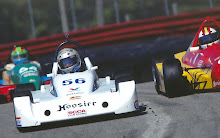
FOLLOW-UP #1 TO: “WHY WE RACE”
In explaining “why we race” I distinguished between “drivers” and “racers”. Racers love the competition and love to win. They will do whatever it takes to win or at least beat that guy/gal that’s finished just ahead of them the last couple races. Winning might be a personal best or beating a rival or friend, regardless of the final finishing position.
I also described racing as a “series of accomplishments”. Successful racers think critically, plan thoroughly, and execute completely. When these activities are focused on making the car/driver combination go faster, they are collectively referred to as “development”. Along with routine maintenance and repairs, development is a constant in motor racing, and by far the most rewarding and enjoyable of the three. Development requires deep thought, creativity, innovation, trial and error, and provides the opportunity for invention and accomplishment (speed). Racers and teams work hard to maximize their time and resources spent on development, making the car/driver go faster. This is why crashes and mechanical failures are so costly, because they take time and resources away from development.
It’s important to note the reason I always say the “car / driver” combination. This is because the driver is often the most important variable in the speed equation. Every driver has preferences and a style. Every driver goes fast differently. One driver may prefer oversteer, a low steering ratio, and firm suspension vs. another driver who likes understeer, high steering ratio, and soft suspension. Of course these are just a few of dozens of car/driver factors, all of which are relative measures.
Many racers classify development activities into four categories:
1. Engineering – car design, redesign, strengthening, lightening, improving in every way.
2. Preparation – ensuring the car/driver are in optimal condition (mechanical/operational/mental) for the upcoming session/s in their current form. This involves checking EVERY nut & bolt on the car, wear items like belts, hoses, brake pads, checking for cracks in chassis, rotors, calipers . . . so basically checking every single piece of the car to ensure it is in proper/optimal working condition. However, driver preparation is also critical . . studying the track/line, notes from previous sessions, planning for driving improvements (where/how you will go faster than last time out), mentally preparing for the expected competition, weather, etc.
3. Set-up – the search for the optimal combination of mechanical and aerodynamic settings that result in the lowest lap time. Common set-up factors include: tire compound, suspension settings, camber/caster/toe, ride height, wing angles, etc.
4. Driving – The constant struggle of the driver to optimize his inputs (steering, throttle, clutch, brake) to the car/package he has resulting in the lowest possible lap time. This includes optimizing the racing line, braking/turning marks, braking/turning style . . threshold braking, trail braking, early/late apexing, and managing traffic . . passing, defending, etc.
It is the ever-growing list for each of these areas from which the “series of accomplishments” is generated. There is always twice as much to do as time or money to do it. Strategy is required. Prioritization is crucial. Planning essential. Time management pivotal. The final accomplishment, winning, makes it all worth while.


No comments:
Post a Comment